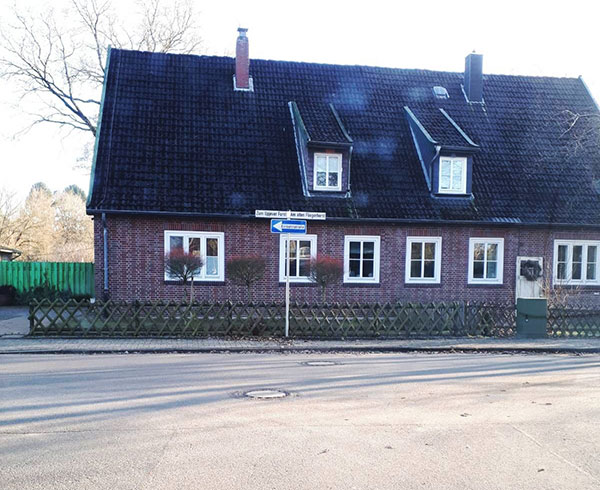
|
|
Sign in the old Married Quarters now reads "Am alten Fliegerhorst" (Schumacherstraße) and "Zum Upjever Forst" (Edertstraße). Suggestion to rename Schumacherstraße and Edertstraße in Upjever to Stanislaw-Maczek- and Josef-Rosensaft-Straße respectively. Supplement / 31.1.2017: On 16 June 2016, at the request of the Green Parliamentary Group, the Council of the City of Schortens decided with the votes of the Greens, the SPD, the FDP, part of the BfG and the vote of Mayor Böhling to rename Schumacherstraße and Edertstraße to Upjever. The CDU and UWG voted against. On 27 August 2016, the city council, with the votes of the SPD, FDP and Greens against the votes of the CDU and the Unabhängiger Wählergemeinschaft (UWG), adopted the new names "Am alten Fliegerhorst" (Schumacherstraße) and "Zum Upjever Forst" (Edertstraße) with effect from 1 October 2016. Two new planned roads in the settlement area are to be called "Zu den Krickmeeren" and "Zum Engelsmeer". This is the name of the streets of the historically important settlement for the region after field names. The names, like alternative others, had been proposed by citizens. Even after this decision, criticism of the eradication of the old names continued among parts of the population. In spite of this decision by the Schortens Council to rename the streets "Am alten Fliegerhorst" (Schumacherstraße) and "Zum Upjever Forst" (Edertstraße) with effect from 1 October 2016, Hartmut Peters made the following case for different names. During the era of National Socialism, the then administration named the two streets of the Upjever airfield settlement after military personnel who had played a role at the military airfield, the construction of which had already been tackled immediately after the so-called "seizure of power" in 1933. Carl-Alfred Schumacher and Hermann Edert are partly strongly connected with the NSDAP and the war of aggression planned without further ado and finally carried out in 1939. Despite the always well-known and repeatedly publicly criticized connection of the persons to the Nazi regime and to Germany's war of aggression against its European neighbors in violation of international law since the 1980s, the street names are still valid today. This amazes and leaves a more than stale feeling in many who know the story. 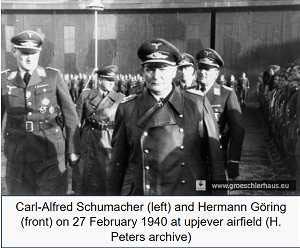 Carl-Alfred Schumacher (1896 - 1967) joined the NSDAP on 1 November 1930, the early entry date shows him as a convinced supporter. He then increasingly closely linked his work with the criminal war actions of Nazi Germany, until he finally arrived in the inner circle of the Luftwaffe and the National Socialist Commanding Officers (NSFO) at the time of the final battle and the total defeat in 1945. The former World War One pilot was reactivated immediately after the "seizure of power" by the NSDAP in March 1933 with simultaneous appointment as a first lieutenant by Berlin for the Luftwaffe to be built. It is important to know that Hitler already at this time and in association with executives of the Reichswehr had the aggressive war for the revision of the Versailles treaties put into concrete planning. Wilhelmshaven as a naval city took on a special significance for the war plan and was expanded into the largest armoury in the Reich. In this context, the National Socialist planners militarized almost everywhere the Frisian hinterland of the now almost doubling of its population. From 1937 Schumacher, now a major, worked for a time as a squadron captain at Upjever airfield, which was put into operation in 1936, and then as an airfield commander. He then took part in the annexation of the Sudetenland at the end of 1938 and the occupation and destruction of Czechoslovakia in March 1939. Stationed in annexed Pilsen, he took part in the invasion of Poland in September 1939. Now a lieutenant colonel, Schumacher became commodore of Jagdgeschwader 1, whose staff was in Jever, after the Polish defeat at the end of 1939. Now he was involved in the war against England, which was allied with Poland. Schumacher's group succeeded in repelling advances of English bombers on the German coastal area in the first phase of the air war. After a successful battle over the southern North Sea from a German point of view on 18 December 1939, Schumacher was celebrated as the "hero of the Battle of the German Bight" throughout the Reich and Luftwaffe chief Hermann Göring inspected the Upjever airfield at the end of February 1940. Schumacher then continued his career in other areas of application. 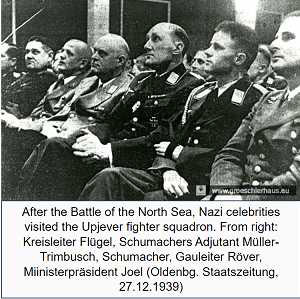 In January 1944, Schumacher reached the rank of Major General. From October 1944 he worked as a voting officer at the Reichskriegsgericht, which had been transferred from Berlin to Torgau on the Elbe, and was demonstrably involved in death sentences against objectors and witnessed executions with a hatchet. On 30 January 1945 he became Chief of the Command Staff of the National Socialist Command Officers (NSFO) in the High Command of the Air Force in the Reich Fuftfahrt Ministry of Goering and held this function until the end of the war. After the defeat of Stalingrad in the "total war", the NSFO was to establish the harmony of soldierhood and "National Socialist worldview" in order to strengthen aggressiveness and sacrifice for the "final victory". The decree on the "ideological leadership" of 6 February 1944 issued by the head of the High Command of the Wehrmacht, Wilhelm Keitel, who was executed in Nuremberg in 1946, lists the selection criteria: "a) unconditional National Socialist, b) special personality value, c) excellent front-line probation, d) experience and practical skills in political-ideological leadership and education." (Bundesarchiv RW 6/490) Schumacher clearly met these criteria and was thus suitable as a senior officer. To clarify: Major General Schumacher was not only an NSFO, as was also the much lower ranking Franz-Josef Strauss, but head of all NSFO of the Luftwaffe. Looking at Schumacher's career from the strengthening of the Nazi movement around 1930 to the "1000-year Reich" to the total defeat of 1945, his coherent actions show him as a convinced and increasingly fanatical co-organizer of Germany's war plans, the war that devastated the entire world and, in particular, as an unconditional National Socialist and advocate of the "final victory". 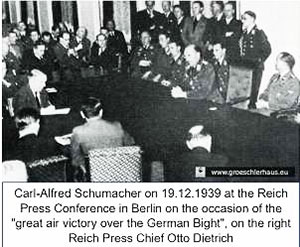 From May 1945 to April 1947 in US captivity, Schumacher was denazified in August 1948, i.e. after the currency reform, as a so-called "follower". "Denazification" is true insofar as this sword, which was only originally sharp immediately after the end of the war in 1945, was at that time effectively synonymous with the creation of the formal prerequisite for being allowed to reintegrate into further professional life. From the time comes the vividly popular term "Persilscheine" for the declarations of honor to be presented for the "whitewashing" of the dirt of the Nazi era. The inclusion of former Nazi activists in the functional elite of the federal republic was on the way and with it what historians call "the second guilt": the cartel of those interested in concealing and suppressing the Nazi era, which lasted until the 1990s. It is doubtful whether Schumacher revealed all the facts of his CV to the decision-makers in 1948. (Unfortunately, the denazification file has not yet been found.) Temporarily living in Jever again, Schumacher, like many former Nazi functionaries, joined the BHE/DP (Bund der Heimatvertriebenen und Entrechteten, German Party), through which he entered the Lower Saxony state parliament in 1953. Of the 33 deputies of the BHE/DP parliamentary group in the Landtag, 28 had previously been members of the NSDAP at that time. Even in the problematic ranks of the BHE, only a few were concretely more burdened than Schumacher. Many members of the CDU and FDP and even some of the rather unsuspicious SPD had a more than just nazi past. In 1958, Schumacher switched from the dissolving BHE to the ailing DP and resigned from the state parliament in 1963, most recently briefly accepted into the CDU parliamentary group like some other former BHElers. 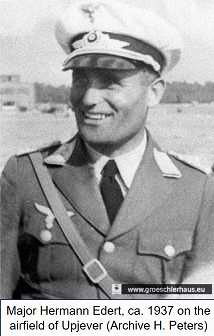 The Edertstraße is so called because under a Major Hermann Edert (born 1901) from July 1936, following the inauguration of the airfield on 1 May 1936, the staff of the central fighter squadron was built and under Edert as Horstkommandant a further expansion of the infrastructure and probably also, as far as currently known, the completion of the airfield settlement took place. Edert had been a member of the right-wing radical Freikorps "Brigade Hermann Ehrhardt" from 1919 and was involved in the failed Kapp putsch against the Reich government in Berlin in March 1920 before becoming a regular marine for a time. In 1933 he joined the Nazi Air Force. In 1937, Edert remained in Jever only until September. He recommended his deputy Schumacher as his successor. During the war he worked as a pilot and pilot training and from 1943 in the rank of colonel as Chief of the German Liaison Staff in the allied Hungarian Air Force. Presumably, Edert is far less burdened than Schumacher. He, whose personal "achievement" - in whatever respect - is insignificant, exhausts himself as a figurehead and representative of a tradition that the National Socialists tried to justify in naming the street and contradicts today's standards, especially civilian communes. Street names are an expression of honor. Schumacherstraße and Edertstraße create a picture of historical continuity that must not remain that of the city of Schortens of today. Also, the naming of the streets at that time apparently took place by the Wehrmacht and not by the municipality (then Oestringen). The decision to retain the names would be the public decision to name the streets. Incidentally, as part of its reappraisal of tradition, the Bundeswehr has been distancing itself for years from names that are burdened by the inhuman ideology and practice of the NSDAP and the war of aggression in violation of international law. This should apply to an even greater extent to a civilian municipality. The Federal Republic of Germany wants to serve "the peace of the world" (Basic Law, preamble). To remedy the obvious public grievance, I propose to name the streets after two personalities who have a connection to German history and the Upjever airfield, who, secondly, are honorable and whose names on a street sign would thirdly stand for a lived culture of remembrance in Schortens: Stanislaw Maczek and Josef Rosensaft. 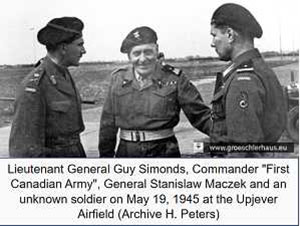 Stanislaw Maczek (1892 - 1994): One of the peculiarities of our regional history is that units of the Polish Western Army, integrated into the British Army, liberated Wilhelmshaven and the northern part of Friesland from National Socialism on 6 May 1945. The 1st Polish Armoured Division under the command of General Stanislaw Maczek had already played an important role in defeating the Nazi terror regime after its landing in Normandy in 1944 at the Battle of Falaise. Stanislaw Maczek took up residence in a Heidmühle villa in May 1945 and on 19 May 1945, together with other high-ranking military officers, stayed at the Upjever airfield, where a field service and a tribute to Polish and British soldiers took place. The Polish soldiers were accommodated in the barracks of the airfield. 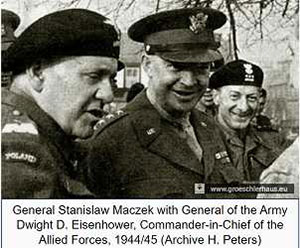 Maczek enjoyed great prestige among allies such as Eisenhower and Montgomery. Since the fall of the Berlin Wall in 1990, Poland has also honoured the non-communist Maczek, who is an honorary citizen of the Netherlands and is buried in Breda, several times. In 1994 he received the highest state award in Poland, numerous streets and schools are named after him. While for Polish historical consciousness the participation of the Western Army in the suppression of National Socialism and the liberation of the homeland from German occupation is self-evident and the capture of the important naval region Wilhelmshaven plays a special role, this episode is almost unknown to Germans. This is all the more regrettable because without the deployment of soldiers like these, Germany would not have been liberated from the terror regime of National Socialism, since all resistance movements failed. 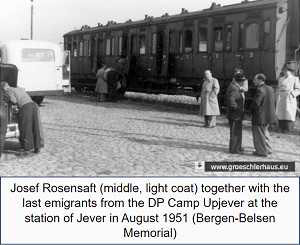 Josef Rosensaft (1911 - 1975): At Bergen-Belsen one thinks of the concentration camp liberated in 1945 and the bodies of the victims found there by the horrified British soldiers. Rarely does one think of the largest camp in post-war Germany for Jewish Displaced Persons (DPs), which was set up here after the demolition of the contaminated barracks, in which, in addition to the liberated, the survivors of many other camps also found accommodation until their emigration or repatriation. Almost unknown, however, is that the history of the "Bergen Belsen D.P. Hohne Camp" came to an end in the personnel buildings of the former Nazi airfield Upjever. The "Resettlement Transit Camp Jever" is one of the most important places of remembrance not only in Friesland, but far beyond, because here the chapter of the history of the Holocaust survivors of the British-occupied zone of Germany and its self-government in 1950/51 was completed. Born in Bedzin near Krakow, Josef Rosensaft survived Auschwitz and Bergen-Belsen, where he was elected to the "Central Committee of Liberated Jews in the British-Occupied Zone" after the liberation. He was the most important negotiating partner of the British on all issues concerning the interests of the Jewish DPs, in particular emigration to Palestine or Israel. When the DP Camp Bergen Belsen was dissolved for military reasons, the controversial Rosensaft pushed through the transfer of the last approximately 1,500 unemployed, traumatized and often physically ill survivors to Upjever, because he saw the best conditions in the buildings left in good condition by the withdrawn Danish occupation troops, especially in the hospital building. This was the last place of the headquarters of the aforementioned Central Committee. Rosensaft lived temporarily in Upjever and organized the dissolution on site in 1951. On the advice of Dr. Thomas Rahe, the director of the Bergen-Belsen Memorial, the son Menachem Z. Rosensaft, NYC, was asked in advance whether he would agree if such a street name were decided by the city. Because even a rejection by the family would be conceivable. Mr. Rosensaft: "Having a street in Upjever - known to the DP's as Jever - named for my father is a beautiful and meaningful gesture of which I approve wholeheartedly. [..] Needless to say, if at all possible, I would like to attend the ceremony." (30.1.2016) Born in Bergen-Belsen in 1948, Rosensaft is the founder of the "International Network of Children of Jewish Holocaust Survivors", chairman of the "Holocaust Survivors' Memoirs Project" together with Yad Vashem, Israel, and since 2008 chief counsel of the World Jewish Congress (WJC). His mother Hadassah Rosensaft née Bimko (1912 - 1997) survived Auschwitz and Bergen-Belsen like her husband. She was a driving force behind the founding and establishment of the United States Holocaust Memorial Museum in Washington, D.C. 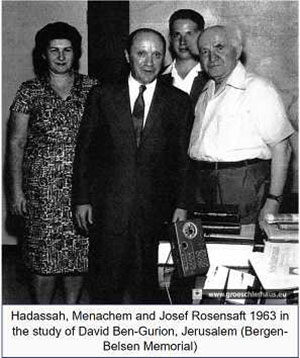 For several months, the history of the "Resettlement Transit Camp Jever" has been researched as part of the project "Places of Remembrance in the District of Friesland" of the Kulturverbund Schloss-Museum Jever and the GröschlerHaus working group, a publication and an exhibition are planned. There are constructive contacts with the Bundeswehr and the idea of integrating a permanent exhibition on the DP camp at the airfield. The initiatives are carried out in consultation with the Bergen-Belsen Memorial and the Oldenburg Landscape. Contacts with family members of Stanislaw Maczek in Edinburgh, Scotland, as well as with veterans' organizations there, in Breda and in Poland can be established or already exist. From the point of view of Polish veterans' associations, it would be an honour primarily for the city of Schortens if one of its streets were allowed to bear Maczek's name. It can be assumed that visitors can also be expected to attend the inauguration of Germany's first Maczek Street, although roads and schools in Poland, the Netherlands and Belgium already commemorate the general. In Edinburgh, a monument was inaugurated in a public park a few months ago. In my opinion, the city of Schortens would be well advised to deal with this Nazi legacy in such a way that a culture of remembrance is permanently created. The street renames, as shown, offer the opportunity to establish the beginnings of memory now also in the second largest city of Friesland, to meet with supra-local interest and, last but not least, to send a historically connecting signal to the Polish twin town Pieszyce. I will only give one suggestion for discussion here: the elected representatives are responsible for the picture that the city of Schortens has not yet drawn in this area or may now draw. The names to be retained is in fact the decision on the naming of streets with Nazi victims. However, to name the streets with e.B field names instead would be a misleading historical smoothing at the site of the historic airfield settlement. The name "Waldsiedlung", which has since emerged, already sounds like a waste disposal park - for a chapter in its history that has not yet been opened by the city of Schortens. Of course, the city should support the residents in taking over and entering their new addresses as cost-neutrally as possible. Schortens also tolerated the fact that the names of Hitler have "just run through" to this day. (Thanks to Marcus Christ.) |